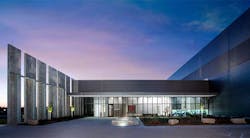Meta Adds More Data Centers in Iowa, Pushing Campus to 5 Million SF
Altoona, Iowa will become Meta’s largest cloud campus with the addition of two new data centers, the company said Tuesday. The new capacity will boost Altoona to more than 5 million square feet of data center space, pushing it past the company’s Prineville, Oregon campus (4.6 million square feet).
The new construction continues the extraordinary growth of the cloud cluster in Iowa, which also features one of the largest Google data centers in Council Bluffs, and multiple sites for Microsoft server farms in West Des Moines. The three companies plan to invest at least $10 billion in their data centers in Iowa.
The new construction comes just six months after the most recent addition.
“This is our seventh expansion announcement for the Altoona Data Center where we started building in 2013,” Meta said in its announcement. “More than 400 people work on-site in data center operations each day. The buildout is expected to be completed in 2025, which means an average of 1,000 construction workers have been on-site for over 12 years. This campus represents a capital investment of more than $2.5 billion in the City of Altoona and the state of Iowa.”
Meta Keeps Building
Meta continues a massive global expansion of its infrastructure. Over the past year, it has announced new data centers in Illinois and Tennessee, as well as major expansions of existing campuses in Utah, Georgia and Prineville, Oregon, where the company is rolling out a multi-story data center design featuring two floors of server rooms to boost capacity.
The company now operates company’s 18 data centers, which upon completion will span more than 40 million square feet of data center space, including 34.2 million square feet of campus capacity in the U.S., and 5.4 million square feet (499,000 square meters) of global space planned for sites in Ireland, Sweden, Denmark and Singapore.
Cloud campuses like the Meta Altoona project concentrate massive amounts of computing power in multiple data center facilities. These data center hubs enable companies to rapidly add cloud capacity and electric power, creating economies of scale as more workloads migrate into these massive server farms.
Meta is always in building mode to support the growing global audience for its platforms, which include Facebook, Instagram and Messenger. The company recently said it has 47 data centers under construction, including capacity expansions within existing buildings as well as new construction at multiple sites.
That will likely continue as Meta builds upon its existing infrastructure to create a metaverse – a virtual world populated by 3D avatars.
Iowa Becoming Data Center Central
Iowa has benefited from a confluence of factors that make it attractive to data centers, including its location, which provides low latency to deliver online services to the center of the country. The state has relatively low costs for land and utility power, and lower exposure to natural disasters than many areas of the nation, with low risk from hurricanes and earthquakes. Data center projects also benefit from incentive programs passed by the Iowa legislature.
As Internet titans seek to distribute large files to support videos, gaming and virtual reality, the center of the country is proving to be the ideal place to add data center capacity. Placing data centers in the center of the country makes it easier to distribute content to major markets like Chicago and Dallas, reducing lag and buffering for streaming media like Netflix movies or Facebook videos. It also allows for data to move quickly to either coast, which can be important in application development.
The Meta team noted the impact the ongoing development has on the Iowa community. “Since 2013, we’ve poured 400,000 yards of concrete, erected 26,000 tons of steel, and accumulated 8.7 million work hours,” Meta said. “Our goal is to continue to build and operate the most energy efficient data centers in the world.”
About the Author



